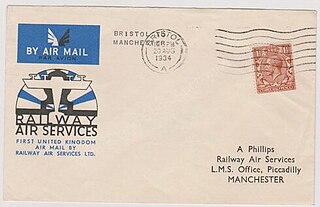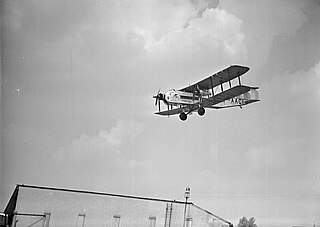Related Research Articles

Imperial Airways was an early British commercial long-range airline, operating from 1924 to 1939 and principally serving the British Empire routes to South Africa, India, Australia and the Far East, including Malaya and Hong Kong. Passengers were typically businessmen or colonial administrators, and most flights carried about 20 passengers or fewer. Accidents were frequent: in the first six years, 32 people died in seven incidents. Imperial Airways never achieved the levels of technological innovation of its competitors and was merged into the British Overseas Airways Corporation (BOAC) in 1939. BOAC in turn merged with the British European Airways (BEA) in 1974 to form British Airways.
This is a list of aviation-related events from 1934:

The Avro York was a British transport aircraft developed by Avro during the Second World War. The design was derived from the Avro Lancaster heavy bomber, several sections of the York and Lancaster being identical. Due to the importance of Lancaster production, York output proceeded slowly until 1944, after which a higher priority was placed upon transport aircraft.
British South American Airways (BSAA) was a state-run airline of the United Kingdom in the mid-to-late 1940s responsible for services to the Caribbean and South America. Originally named British Latin American Air Lines, it was renamed before services started in 1946. BSAA operated mostly Avro aircraft: Yorks, Lancastrians and Tudors and flew to Bermuda, the West Indies, Mexico and the western coast of South America. After two high-profile aircraft disappearances it was merged into the British Overseas Airways Corporation at the end of 1949.

The Avro 618 Ten or X was a passenger transport aircraft of the 1930s. It was a licensed version by Avro of the Fokker F.VIIB/3m.

Railway Air Services (RAS) was a British airline formed in March 1934 by the Big Four railway companies and Imperial Airways. The airline was a domestic airline operating routes within the United Kingdom linking up with Imperial's services.

The Handley Page W.8, W.9 and W.10 were British two- and three-engine medium-range biplane airliners designed and built by Handley Page.
Lympne Airport was a military and later civil airfield, at Lympne, Kent, United Kingdom, which operated from 1916 to 1984. During the First World War RFC Lympne was originally an acceptance point for aircraft being delivered to, and returning from, France but was later designated as a First Class Landing Ground, RAF Lympne. It became a civil airfield in 1919 and saw the operation of early air mail services after the 1918 armistice. It was one of the first four airfields in the United Kingdom with customs facilities.

Turkish Airlines Flight 634 was a scheduled domestic passenger flight from Turkish Airlines' hub at Istanbul Atatürk Airport to Diyarbakır Airport in southeastern Turkey. On 8 January 2003 at 20:19 EET, the aircraft operating the flight, a British Aerospace Avro RJ100, struck the ground on final approach approximately 900 metres (3,000 ft) short of the runway threshold during inclement weather conditions. In the following collision with a slope, a post-crash fire broke out, killing 75 of the 80 occupants, including the entire crew.

On 28 March 1933, an Armstrong Whitworth Argosy II passenger aircraft, named City of Liverpool and operated by British airline Imperial Airways, crashed near Diksmuide, Belgium, after suffering an onboard fire; all fifteen people aboard were killed, making it the deadliest accident in the history of British civil aviation to that time. It has been suggested that this was the first airliner ever lost to sabotage, and in the immediate aftermath, suspicion centred on one passenger, Albert Voss, who seemingly jumped from the aircraft before it crashed.

The 1950 Heathrow BEA Vickers Viking crash occurred on 31 October 1950 when a Vickers Viking operated by British European Airways (BEA) crashed at London Airport in heavy fog. The aircraft was on a scheduled flight between Paris and London's Northolt airport and 28 of the 30 passengers and crew on board were killed.

The 1934 Hillman's Airways de Havilland Dragon Rapide crash occurred on 2 October 1934 when a de Havilland DH.89A Dragon Rapide of Hillman's Airways crashed into the English Channel off Folkestone, Kent, killing all seven people on board. The aircraft was operating an international scheduled passenger flight from Abridge Aerodrome to Le Bourget Airport, Paris. The accident resulted in the first write-off of a Dragon Rapide.

The 1929 Imperial Airways Handley Page W.10 crash happened on 17 June 1929 when Handley Page W.10 G-EBMT suffered an engine failure and subsequently ditched in the English Channel off Dungeness with the loss of seven lives. The aircraft was operating an international scheduled flight from Croydon to Le Bourget Airport, Paris, France.

The 1962 Channel Airways Dakota accident occurred on 6 May 1962 when a Channel Airways Douglas C-47A Dakota, registered G-AGZB and operating a scheduled passenger flight from Jersey to Portsmouth, collided with a cloud-covered hill at St Boniface Down, near Ventnor on the Isle of Wight. The aircraft had previously been owned by British European Airways, and was named "Robert Smith-Barry". The aircraft was destroyed, and twelve of the eighteen occupants were killed.

The 1947 BOAC Douglas C-47 Crash occurred on 11 January 1947 when Douglas C-47A G-AGJX of British Overseas Airways Corporation (BOAC) crashed into a hill at Stowting, Kent, in southeast England, killing five people outright, with a further three dying from injuries received. The aircraft had been operating a scheduled international flight to West Africa via France. Poor weather caused the aircraft to attempt to divert. After attempts to land at a number of French airports, the pilot decided to return to the United Kingdom as he was running short of fuel. The aircraft crashed while attempting to land at Lympne Airport.

On 2 February 1953, an Avro York four-engined piston airliner registered G-AHFA of Skyways disappeared over the North Atlantic on a flight from the United Kingdom to Jamaica. The aircraft had 39 occupants including 13 children.

The 1923 Daimler Airway de Havilland DH.34 crash occurred on 14 September 1923 when a de Havilland DH.34 of Daimler Airway operating a scheduled domestic passenger flight from Croydon to Manchester crashed at Ivinghoe, Buckinghamshire, England, killing all five people on board.

The 1924 Imperial Airways de Havilland DH.34 crash occurred on 24 December 1924 when de Havilland DH.34 G-EBBX of Imperial Airways crashed at Purley, Surrey, United Kingdom killing all eight people on board. The aircraft was operating a scheduled international flight from Croydon, Surrey, to Paris, France. It was the first fatal accident suffered by Imperial Airways and led to the first public inquiry into a civil aviation accident in the United Kingdom. As a result of issues brought up during the inquiry, Croydon Airport was expanded, absorbing most of Beddington Aerodrome.

Captain Charles Francis Wolley-Dod was a British pilot and aviation executive. He was one of Imperial Airways' early pilots and later became their European manager. Imperial was an early British commercial long-range airline, operating from 1924 to 1939, and Wolley-Dod developed several of their commercial routes between London, South Africa, the Middle East, and India.
References
- ↑ "Civil Aircraft Register – Great Britain". Golden Years of Aviation. Retrieved 16 April 2014.
- 1 2 3 4 "Air Crash in Belgium". The Times. No. 46640. London. 1 January 1934. col D, p. 12.
- ↑ "Imperial Airways machine crashes in fog". Flight (4 January 1934): 17.
- 1 2 "The Air Liner Crash". The Times. No. 46644. London. 5 January 1934. col B, p. 11.
- ↑ "Wrecked Air Liner". The Times. No. 46441. London. 2 January 1934. col E, p. 9.
- ↑ "Air Crash in Belgium". The Times. No. 46642. London. 3 January 1934. col G, p. 9.
- ↑ "Civil Cross for Ruysselede crash rescuer". Flight (11 January 1934): 41.
- ↑ "The Apollo Disaster". The Times. No. 46657. London. 20 January 1934. col B, p. 10.